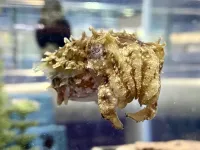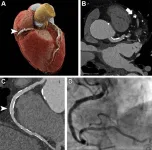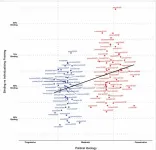(Press-News.org) As director of SRI’s Human Sleep Research Program, Fiona Baker studies the complex interplay between sleep and overall health and well-being.
Much of her work has been focused on sleep patterns in adult women, but recently her attention has turned to adolescents. Adolescence is a crucial time for developing healthy sleep patterns as it is for brain development. In her research, Baker draws clear lines of connection between the two.
“Sleep is so important to us all, but especially for teenagers or adolescents,” Baker says. “Between the ages of 10 and 21, or so, and even a little later, the brain develops and matures in fundamental ways. By studying sleep we’re trying to understand not just sleep as a behavior but also its importance for the entire brain and for lifetime well-being.”
During this period, Baker explains, the brain is becoming more efficient, getting rid of—or “pruning” in neurological terms—brain connections that are more relevant in childhood, while strengthening more important ones that the young person will rely on the rest of their lives.
If a teen’s sleep patterns are less than ideal, it can affect brain development and overall health. In addition to studying underlying mechanisms linking sleep, the developing brain, and health in teens, Baker’s lab is also working to develop behavioral guidelines to help adolescents find healthier balances.
“Sufficient, quality sleep is really important for healthy behavioral, emotional, and cognitive development in adolescents, and lack of sleep is tied to weight gain, poor cognitive development, and socioemotional difficulties,” Baker says. “We really need to understand this period better in terms of sleep’s connection to these concerns.”
From too much screentime to anxiety and alcohol use, there is litany of familiar teenage concerns that can disrupt sleep and, by consequence, brain development. In one recent study, she looked at bedtime screen use (phone, computer, television) in more than 10,000 children between the ages of 10 and fourteen to uncover several interesting findings.
More than a quarter (28%) experienced sleep disturbances, but those who had a TV or an Internet-connected electronic device in the bedroom had more trouble falling and staying asleep and more overall sleep disturbance. Worse yet, those who left their ringers on overnight had it much worse than those who turned them off. Common teenage bedtime routines, such as streaming movies, playing video games, listening to music, talking/texting on the phone, and using social media or chat rooms, were all associated with greater sleep challenges.
Another study looked at how changing sleep patterns like later bedtimes and increased screen time brought on by the COVID-19 pandemic had lasting impacts on teenage sleep. Screen time increased steeply in the pandemic period as teens attended school online, wiled away free time on video games, and turned to social media to stay connected to friends. In the study, social media use and video gaming were particularly associated with shorter time in bed, later bedtimes, and delayed sleep onset.
“Sleep patterns for teens during the pandemic were dramatically different than before COVID-19,” Baker says. “These trends are both intriguing and concerning. It is important to promote teen awareness and education about better use of screens and to help families to develop workable media use plans for their kids such as turning off all devices before bedtime and allowing a winding-down period of at least 30 minutes without screens before sleep.”
A third recent paper by Baker and colleagues was an observational study that tracked brain scans of a cohort of 94 teens over a four-year period looking at how emergent alcohol use altered sleep continuity, sleep architecture—the different parts of sleep—and the brain’s electrical patterns as measured by EEG.
“We’re seeing that if teenagers start to drink heavily they have a more disturbed sleep,” Baker says. “It’s too early to tell, however, if stopping drinking can return things to normal or if the changes persevere.”
All of Baker’s recent studies point to greater adolescent awareness of the detrimental behaviors that can impact sleep, health and well-being, as well as to the need for greater parental oversight of teen activities that are known to have a harmful effect on teen sleep. They also point to the positive effects that sufficient quality sleep might have to support healthy development.
“Better understanding of teenage sleep and its connections to overall health is helping us to develop strategies to address these troubling patterns,” Baker says. “The good news, however, is that the teenage brain is quite resilient, and we are hopeful that with behavioral adaptations we can help these kids recover and get back on track for a lifetime of good sleep and good health.”
END
Exploring the deep connections between adolescent sleep and overall health
Fiona Baker of SRI’s Human Sleep Lab discusses how good sleep patterns are critical for brain development in our early years.
2023-06-20
ELSE PRESS RELEASES FROM THIS DATE:
SRI seeks to learn how insects speak through smells
2023-06-20
All around us, insects are speaking to each other: jockeying for mates, searching for food, and trying to avoid becoming someone else’s next meal. Some of this communication is easy to spot—like the flashes of fireflies on a summer night or a screaming chorus of cicadas in the afternoon—but many of the most sophisticated conversations are challenging to observe, occurring through an exchange of chemical scents.
Understanding chemical communication could be the key to finding new, more effective ways to protect crops or ward off biting insects that can transmit diseases. Researchers ...
Cuttlefish brain atlas first of its kind
2023-06-20
NEW YORK, NY — Anything with three hearts, blue blood and skin that can change colors like a display in Times Square is likely to turn heads. Meet Sepia bandensis, known more descriptively as the camouflaging dwarf cuttlefish. Over the past three years, a team led by neuroscientists at Columbia’s Zuckerman that includes data experts and web designers has put together a brain atlas of this captivating cephalopod: a neuroanatomical roadmap depicting for the first time the brain’s overall 32-lobed structure as well its cellular organization.
The ...
Climate action plans mobilize limited urban change, researchers report
2023-06-20
The Intergovernmental Panel on Climate Change Fifth Assessment Report (AR5), released just prior to an international climate convention in 2015, explicitly stated that human-caused greenhouse gas emissions were the highest in history, with clear and widespread impacts on the climate system. Since then, hundreds of cities across the world have published their own climate action plans (CAPs), detailing how their urban areas will handle climate change. How do the plans stack up against one another and against the recommended ...
Photon-counting CT noninvasively detects heart disease in high-risk patients
2023-06-20
OAK BROOK, Ill. – New ultra-high-resolution CT technology enables excellent image quality and accurate diagnosis of coronary artery disease in high-risk patients, a potentially significant benefit for people previously ineligible for noninvasive screening, according to a study published in Radiology, a journal of the Radiological Society of North America (RSNA).
Coronary artery disease is the most common form of heart disease. Coronary CT angiography (CCTA) is highly effective for ruling out coronary artery disease ...
Self-driving revolution hampered by a lack of accurate simulations of human behavior
2023-06-20
Self-driving revolution hampered by a lack of accurate simulations of human behaviour
Algorithms that accurately reflect the behaviour of road users - vital for the safe roll out of driverless vehicles - are still not available, warn scientists.
They say there is “formidable complexity” in developing software that can predict the way people behave and interact on the roads, be they pedestrians, motorists or bike riders.
To improve the modelling, a research team led by Professor Gustav Markkula from the Institute of Transport Studies ...
Toxic emissions from wildland-urban interface fires
2023-06-20
Fires in the wildland-urban interface (WUI) emit more toxic smoke than wildfires burning in natural vegetation, due to the chemicals in the structures, vehicles, and other manufactured goods that burn in fires in areas of human habitation. Amara Holder and colleagues surveyed the literature on emissions from urban fuels, finding 28 experimental studies that reported emission factors—emissions per unit of fuel burned—for various items, such as home furnishings, consumer electronics, and vehicle ...
Electing progressives with patriotism, family, and tradition
2023-06-20
Economically progressive candidates may fare better in US elections when delivering their message in terms of “binding values” such as patriotism, family, and respect for tradition, according to a study. Although large majorities of Americans favor increasing economic equality in the United States, candidates who promote policies intended to reduce economic inequality, such as raising the minimum wage or increasing access to health care, often fare poorly at the ballot box. One reason for their under-performance may ...
Locating executive functions in fish brains
2023-06-20
The telencephalon is the part of the brain responsible for executive functions in fish, according to an experimental study. Zegni Triki and colleagues used guppies (Poecilia reticulata) that had been selected over five generations to have smaller or larger telencephalons, resulting in a 10% size difference between “up selected” and “down selected” lines of fish. Total brain size was not significantly affected. The authors then presented 48 male fifth-generation fish from both lines with tests of cognitive flexibility, inhibitory control, and working memory—the three commonly accepted components ...
Modeling human behavior for autonomous vehicles
2023-06-20
A model of human psychology could help self-driving cars interact with human drivers on the road, according to a study. Gustav Markkula and colleagues combined several computational psychological models into one master-model to simulate pedestrians attempting to cross a busy road and the human drivers on that road. The goal of the model was to capture the underlying cognitive mechanisms responsible for observed behavior. Computational models of Bayesian perception, theory of mind, behavioral game theory, long-term valuation of ...
Cholesterol lures in coronavirus
2023-06-20
A recent study unveiled the doorway that SARS-CoV2 uses to slip inside cells undetected.
SARS-CoV-2 uses the receptor angiotensin-converting enzyme 2, or ACE2, to infect human cells. However, this receptor alone does not paint a complete picture of how the virus enters cells. ACE2 is like a doorknob; when SARS-CoV-2 grabs it and maneuvers it precisely, this allows the virus to open a doorway to the cell’s interworking and step inside. However, the identity of the door eluded scientists.
Scott Hansen, an associate ...
LAST 30 PRESS RELEASES:
Common eye ointment can damage glaucoma implants, study warns
ACCESS-AD: a new European initiative to accelerate timely and equitable AD diagnosis, treatment and care
Mercury exposure in northern communities linked to eating waterfowl
New Zealand researchers identify brain link to high blood pressure
New research confirms people with ME/CFS have a consistent faulty cellular structure
Hidden cancer risk behind fatty liver disease targets
Born in brightness, leading to darkness
Boron-containing Z-type and bilayer benzoxene
Hong Kong researchers break the single-field barrier with dual-field assisted diamond cutting
Work hard, play hard?
Wood becomes smart glass: Photo- and electro-chromic membrane switches tint in seconds
The Lancet: COVID-19 vaccine hesitancy decreased over time, though mistrust persists among certain groups, study of over 1 million people in England suggests
Psychosis patients ‘living in metaphor’ -- new study radically shifts ideas about delusions
Clinical trial in Ethiopia targets the trachoma scourge
Open-sourcing the future of food
Changes in genetic structure of yeast lead to disease-causing genomic instabilities
UC San Diego Health Sciences Grant Writing Course helps launch successful research careers
Study: Many head and neck cancer trials end early. Why?
Tufts vice provost for research named Foreign Fellow of Indian National Science Academy
New model improves prediction of prostate cancer death risk
Two wrongs make a right: how two damaging variants can restore health
Overlooked decline in grazing livestock brings risks and opportunities
Using rare sugars to address alcoholism
Research alert: New vulnerability identified in aggressive breast cancer
Ruth Harris honored with SSA Distinguished Service Award
Treasure trove of data on aging publicly accessible
Trees4Adapt project to address risks from climate change and biodiversity loss through tree-based solutions
Nature Communications study from the Lundquist Institute identifies molecular mechanism underlying peripartum cardiomyopathy
Pennington Biomedical’s Dr. Gang Hu appointed to NIH Reproductive, Perinatal and Pediatric Health Review Group
World-first project shows great promise to treat low eye pressure
[Press-News.org] Exploring the deep connections between adolescent sleep and overall healthFiona Baker of SRI’s Human Sleep Lab discusses how good sleep patterns are critical for brain development in our early years.






